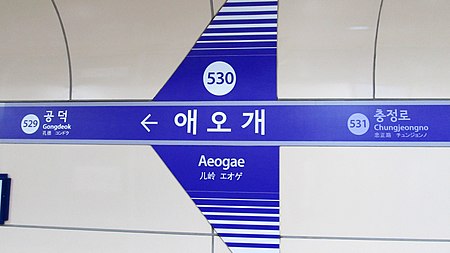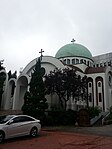Aeogae station
Metro stations in Mapo DistrictRailway stations opened in 1996Seoul Metropolitan Subway stationsSeoul metro station stubs

Aeogae is a subway station in Mapo-gu, which is located in Seoul, South Korea. It is served by Seoul Subway Line 5."Aeogae" is one of a very few station names in the Seoul subway system which is not ultimately derived from Chinese. The name is derived from a native Korean designation meaning "small ridge." This is the literal translation of the neighborhood called Ahyeon-dong, in which this station is located.
Excerpt from the Wikipedia article Aeogae station (License: CC BY-SA 3.0, Authors, Images).Aeogae station
Mapo-daero, Seoul
Geographical coordinates (GPS) Address Nearby Places Show on map
Geographical coordinates (GPS)
| Latitude | Longitude |
|---|---|
| N 37.553444444444 ° | E 126.95666666667 ° |
Address
애오개
Mapo-daero
04207 Seoul
South Korea
Open on Google Maps








